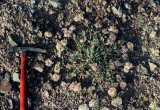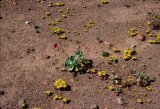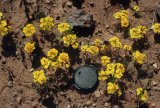 |
QUICK SEARCH
MO PROJECTS:
Africa
Asia/Pacific
Mesoamerica
North America
South America
General Taxonomy
Photo Essays
Training in Latin
America
MO RESEARCH:
Wm. L. Brown Center
Bryology
GIS
Graduate Studies
Research Experiences
for Undergraduates
Imaging Lab
Library
MBG Press
Publications
Climate Change
Catalog Fossil Plants
MO DATABASES:
W³MOST
Image Index
Rare Books
Angiosperm
Phylogeny
Res Botanica
All Databases
INFORMATION:
What's New?
People at MO
Visitor's Guide
Herbarium
Jobs & Fellowships
Symposium
Research Links
Site Map
Search
Cruckshanksia Hook. & Arn. (Rubiaceae: Coussareae)Charlotte M. Taylor [webpage]
Cruckshanksia Hook. & Arn. includes seven species of low, hemicryptophytic shrubs and annual herbs found in the Atacama Desert and the Andes of nothern to central Chile and adjacent Argentina. Cruckshanksia can be recognized by its opposite leaves, its interpetiolar stipules that are triangular to bilobed or erose, its flowers borne severally in terminal cymes, its yellow or pink salverform corollas with slender long tubes, and its papery loculicidal capsules. The flowers are diurnal and distylous. The tissue do contain raphides, although these may be difficult to observe. The leaves and inflorescence bracts of several species of Cruckshanksia may be deeply 2-3-lobed. Several species have one or more calyx lobes on each flower that are expanded into calycophylls (i.e., expanded foliaceous structures), which are petaloid and white to colored in flower and later become papery. In flower these structures presumeably help attract pollinators, while in fruit they apparently aid in dispersal or at least dehiscence of the capsules. The annual species C. pumila grows in regions of the Atacama Desert that only receive rain during El Niño years, thus only for a couple weeks every third to fifth year; its seeds are dormant on the ground between rains. Cruckshanksia hymenodon is the most widely distributed and frequently collected species of this genus. Cruckshanksia has been confused with another genus of southern South America, Oreopolus Schltdl. However these genera differ in several characters, as summarized in the key presented on the Oreopolus web page. Cruckshanksia and its relationship to Oreopolus have been studied by Ricardi (1963), Ricardi & Quezada (1963), and Taylor (1996). Ricardi (1963) and Ricardi & Quezada (1963) recognized seven species of Cruckshanksia and three of Oreopolus; however Taylor (1996) recognized only seven species of Cruckshanksia, including two of the species that Ricardi & Quezada included in Oreopolus. Cruckshanksia was previously included in the Hedyotideae by many authors, although Bremekamp and later Anderson & Rova (1999) placed it in the Cruckshanksieae. More recently, based on molecular data Bremer & Manen (2000) transferred both Oreopolus and Cruckshanksia to the neotropical tribe Coussareae. In their expanded circumscription Coussareae comprises a notable range of fruit types, from single- to multi-seeded, fleshy, indehiscent fruits (Coussarea, Coccocypselum) to leathery schizocarps (Declieuxia) and dry multi-seeded capsules (Heterophyllaea); it is not yet clear what morphological features unite the genera now placed in this tribe. References
Key to the Species of Cruckshanksia
List of Names and Synonyms of Cruckshanksia Accepted names are presented in bold; synonymous names appear with an equals sign. Further information on these names can be found in the TROPICOS database [http://www.tropicos.org/]. Cruckshanksia bustillosii Phil. = Cruckshanksia hymenodon
Cruckshanksia hymenodon var. bustillosii (Phil.) Ricardi = Cruckshanksia Cruckshanksia lithiophila Ricardi, Andes of northern Chile, 3300-3600 m Cruckshanksia macrantha Phil., Andes of northern and central Chile and Cruckshanksia montiana Clos, northern Chile, 10-500 m Cruckshanksia palmae Clos, Andes of north-central Chile, 2000-4000 m Cruckshanksia pumila Clos, northern Chile, 10-1900 m Cruckshanksia tripartita Phil. = Cruckshanksia pumila Cruckshanksia verticillata Phil., northern Chile, 100-1000 m Oreopolus macrantha (Phil.) Ricardi = Cruckshanksia macrantha Oreopolus palmae (Clos) Ricardi = Cruckshanksia palmae Rotheria lanceolata Meyen = Cruckshanksia hymenodon
Text and Images, unless otherwise indicated, Copyright © by Charlotte M. Taylor. All rights reserved.
This page was revised on April, 2008.
|
|||||||||||
© 1995-2025 Missouri Botanical Garden, All Rights Reserved
4344 Shaw Blvd.
St. Louis, MO 63110
(314) 577-5100
Technical Support


